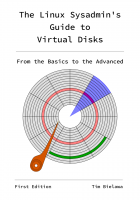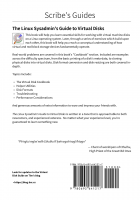-
-
I’m very excited (and proud) to announce that on March 3rd, 2016 I reached a long-term goal I set for myself 3½ years ago, by self-publishing my first book, The Linux Sysadmin’s Guide to Virtual Disks. The book is published under my new brand, Scribe’s Guides.
The first edition of The Virtual Disk Guide has been a long time coming. Nearly 7 years of on-and-off writing have gone into it. I’m relieved to have made it this far.
- Front cover
- Back cover
About the Virtual Disk Guide
I view the book as the definitive reference guide for virtual disk related activities — clear, concise, accurate, and approachable to readers of all skill levels— but that’s just my opinion. You can decide that for yourself.
The book is quite thoroughly cited and annotated with nearly 100 individual footnotes and references to additional learning resources. The book weighs in at around 80 pages, 7 chapters, and two technical appendices. Here’s the byline from the scribesguides.com website:
The Linux Sysadmin’s Guide to Virtual Disks demonstrates the core concepts of virtual disk management. Real-world problems are covered in the book’s “Cookbook” section. Other topics include: helper utilities, disk formats, troubleshooting tips, performance considerations, and comprehensive appendices.
GetBuy one (please?)- Buy a hard copy of the first edition for $10.00
- Read the latest build[1] of the PDF or HTML versions online for free
Or do both! Say “thanks!” by purchasing a copy, and then enjoy the latest builds online forever, for free!
[1] – The original first edition text is also available for free in PDF and HTML formats and is identical to the print copy
Open Source
The official publishing of The Virtual Disk Guide does not change anything about it’s openness or your freedom to remix it however you wish. The book is still freely licensed under the Creative Commons Attribution-ShareAlike 4.0 International License (CC BY-SA 4.0).
All of the source material used to build the book’s body material and cover images are still free and open source, covered under the same license. All digital media displayed in the book, such as figures and the cover art, was created using free/open source software. Each media item was created and saved in digital formats unencumbered by patents.
As ever, if you identify errors in the book or have thought of a way to improve it, please open a ticket on the GitHub issue tracker. If you’ve read a copy of the book already and would like to contribute a review or statement, feel free to reach out to me. Find my email in a github commit, or look at my other contact methods under the author highlight panel on scribesguides.com.
More Blog Posts Coming Soon
The experience of writing and publishing this book has taught me much, and it’s time to spread that information. Check back soon for a follow-up post I’m writing which covers more of the technical side of self-publishing. Specifically, self-publishing a DocBook 5 document at the on-demand printing website lulu.com.
Let me be explicitly clear, this is not a promotion for lulu.com.
Rather, the post will review some of the technical challenges I encountered (old examples: #1, #2, #3) during the publishing process, including challenges specific to Lulu. Such as, how I customized the PDF output from dblatex to look more personal and less generically academic, why I had to order three proof copies of the book before the cover matter printed in decent quality, and how to adjust your inner and outer page margins so there’s a reasonable amount of whitespace between the spine/binding and the body text.
I have a feeling that by the time I’m done with the blog posts I’m going to have written another book of documentation about how I wrote a book of documentation
-
Update 2013-06-23:
Updating to the 0.3.4 version of dblatex has fixed many of the issues detailed in The Aftermath (end of this blog post). See the blog post for more information.
The Problem:
You’re writing a book in DocBook XML, publishing it with dblatex, and you dislike (or want to customize) the fonts it uses in the rendered PDF.
You hunt around the internet and find a nice family of fonts you want to use in your final product. Best of all, they’re free and released under the Open Font License!(Thanks, Adobe!)
The dblatex documentation shows you how to set your fonts, but you can’t seem to get it to work.
- What do you put in for the names anyway?
- Do spaces matter, or do you enter file names?
- Where do you install the fonts?
- OTF, TTF? What type of font must they be?
- Does the TeX engine even support this?
The Solution:
1. Find The Family Names
Caveat: I can verify that this solution works for TTF type fonts, I can not comment on how well it works for other font types.
First, you will need to identify the actual family name of the fonts you want to use. If your font is not installed on your system there is a command called otfinfo that can tell you the family of the font file (despite sounding specific to OTF fonts, this works on TTFs as well). The otfinfo command is provided by the lcdf-typetools package:
If your desired font is already installed on your system you can use the fc-list command instead to find the same information (fc-list is provided by the fontconfig package):
2. Install New Font Files
If this is a new font on your system then you’ll need to install it. There are (at least) two locations that work:
$HOME/.fonts/usr/share/fonts/truetype/
The Font Manager application (package: font-manager) also provides a graphical way to install font collections.
(Optional) Rebuild Font Cache
Rebuild your font caches with the
fc-cache -f -vcommand. If I recall correctly, you need to have super user permissions to run this. I may be wrong though.3. Configure dblatex
The necessary changes to consume your custom fonts isn’t difficult. Assume that up until now you’ve been rendering your PDFs from XML source like this:
dblatex -o output/Virtual-Disk-Operations.pdf Virtual-Disk-Operations.xml
We need to use XSLT stylesheets to define what our chosen font families are going to be. In this example I’m using Source Sans Pro for the body font and Source Code Pro for monospaced sequences.
First, make a directory called xsl and put a file like this in it:
Next, slightly modify the command you run to build your PDFs (new parts are in bold text):
dblatex -p xsl/dblatex-pdf.xsl -b xetex -o output/Virtual-Disk-Operations.pdf Virtual-Disk-Operations.xml
-p xsl/dblatex-pdf.xsl: This tells dblatex that we’re providing a “user stylesheet” to use when transforming the XML. This stylesheet only has our font customizations in it, but you can put much more in them than just that.
-b xetex: This tells dblatex that instead of rendering our PDF with pdftex we want to use a different backend driver (or “TeX engine”). Specifically we want to use the xetex driver. We choose the xetex driver because of it’s superior font handling abilities via the fontspec LaTeX package. When we use the xetex engine dblatex will insert some special macros into the intermediate LaTeX document it generates, this process is transparent to the end user:
After this, dblatex runs any custom post-compilation scripts, and then hands the intermediate file off to xetex where it is finally transformed into PDF format.
4. The Aftermath
In my case there were some unexpected side-effects from switching backends. Here’s what I’ve noticed so far:
- remark elements no longer appear in PDF output
- The DRAFT watermark no longer appears
- screen elements no longer show a ‘wrapping character’ in long lines

On the left is the book rendered with xetex and the new fonts. On the right is the book rendered with pdftex and no special font customizations.
The only thing that really bothers me is the broken word-wrapping character. I can deal with the others breaking. I had intended to remove them from the final product anyway.
-
I ran into this issue while installing dblatex (0.2.10) from the most recent MacPorts tree today:
Traceback (most recent call last): File "/opt/local/bin/dblatex", line 16, in
from dbtexmf.dblatex import dblatex ImportError: No module named dbtexmf.dblatex I got past it by exporting
PYTHONPATH=/opt/local/Library/Frameworks/Python.framework/Versions/2.6/lib/python2.6/site-packages, but clearly this was not optimal. I was about to file a bug report about the issue but before I did that I read their new ticket guidelines which requested the full build log be included in the ticket.In the build log was the solution. I would have missed it had my shell scrollback not been set to unlimited. Nestled a good 182 lines back in my buffer was this little message:
---> Installing python26 @2.6.4_0+darwin ---> Activating python26 @2.6.4_0+darwin To fully complete your installation and make python 2.6 the default, please run sudo port install python_select sudo python_select python26
I did as instructed, and sure enough, dblatex started working! I just wanted to post this on the blog in case anyone else ran into this and missed it like I did.
-


